Une partie des informations de ce site Web a été fournie par des sources externes. Le gouvernement du Canada n'assume aucune responsabilité concernant la précision, l'actualité ou la fiabilité des informations fournies par les sources externes. Les utilisateurs qui désirent employer cette information devraient consulter directement la source des informations. Le contenu fourni par les sources externes n'est pas assujetti aux exigences sur les langues officielles, la protection des renseignements personnels et l'accessibilité.
L'apparition de différences dans le texte et l'image des Revendications et de l'Abrégé dépend du moment auquel le document est publié. Les textes des Revendications et de l'Abrégé sont affichés :
| (12) Brevet: | (11) CA 2308469 |
|---|---|
| (54) Titre français: | BUSE REFRACTAIRE |
| (54) Titre anglais: | REFRACTORY NOZZLE |
| Statut: | Périmé et au-delà du délai pour l’annulation |
| (51) Classification internationale des brevets (CIB): |
|
|---|---|
| (72) Inventeurs : |
|
| (73) Titulaires : |
|
| (71) Demandeurs : |
|
| (74) Agent: | SMART & BIGGAR LP |
| (74) Co-agent: | |
| (45) Délivré: | 2010-04-13 |
| (86) Date de dépôt PCT: | 1999-09-01 |
| (87) Mise à la disponibilité du public: | 2000-03-16 |
| Requête d'examen: | 2004-08-04 |
| Licence disponible: | S.O. |
| Cédé au domaine public: | S.O. |
| (25) Langue des documents déposés: | Anglais |
| Traité de coopération en matière de brevets (PCT): | Oui |
|---|---|
| (86) Numéro de la demande PCT: | PCT/GB1999/002877 |
| (87) Numéro de publication internationale PCT: | WO 2000013822 |
| (85) Entrée nationale: | 2000-05-03 |
| (30) Données de priorité de la demande: | ||||||
|---|---|---|---|---|---|---|
|
Cette buse réfractaire est constituée d'un élément supérieur (20) et d'un élément inférieur (22) présentant des perçages coniques complémentaires. Ces éléments, qui s'adaptent l'un sur l'autre de façon que les perçages coïncident, sont bloqués dans le trou (16) du fond du récipient métallurgique par une platine de retenue (66) et une platine de fond (86). Cette platine de fond (86) peut être déposée de façon à permettre le remplacement de l'élément inférieur (22) sans avoir à intervenir sur l'élément supérieur.
A refractory nozzle comprises upper and
lower members (20 and 22) having matching
tapered bores. The members fit together so
that the bores match, and are secured in the
hole (16) in the bottom of a metallurgical
vessel by a retaining plate (66) and a bottom
plate (86). The bottom plate (86) can be
removed to allow the lower member (22) to be
replaced without disturbing the upper member.
Note : Les revendications sont présentées dans la langue officielle dans laquelle elles ont été soumises.
Note : Les descriptions sont présentées dans la langue officielle dans laquelle elles ont été soumises.

2024-08-01 : Dans le cadre de la transition vers les Brevets de nouvelle génération (BNG), la base de données sur les brevets canadiens (BDBC) contient désormais un Historique d'événement plus détaillé, qui reproduit le Journal des événements de notre nouvelle solution interne.
Veuillez noter que les événements débutant par « Inactive : » se réfèrent à des événements qui ne sont plus utilisés dans notre nouvelle solution interne.
Pour une meilleure compréhension de l'état de la demande ou brevet qui figure sur cette page, la rubrique Mise en garde , et les descriptions de Brevet , Historique d'événement , Taxes périodiques et Historique des paiements devraient être consultées.
| Description | Date |
|---|---|
| Le délai pour l'annulation est expiré | 2018-09-04 |
| Requête pour le changement d'adresse ou de mode de correspondance reçue | 2018-01-12 |
| Lettre envoyée | 2017-09-01 |
| Accordé par délivrance | 2010-04-13 |
| Inactive : Page couverture publiée | 2010-04-12 |
| Inactive : Taxe finale reçue | 2010-01-28 |
| Préoctroi | 2010-01-28 |
| Un avis d'acceptation est envoyé | 2009-08-25 |
| Lettre envoyée | 2009-08-25 |
| Un avis d'acceptation est envoyé | 2009-08-25 |
| Inactive : Approuvée aux fins d'acceptation (AFA) | 2009-07-29 |
| Modification reçue - modification volontaire | 2009-03-26 |
| Inactive : Dem. de l'examinateur par.30(2) Règles | 2008-12-16 |
| Modification reçue - modification volontaire | 2008-05-13 |
| Inactive : Dem. de l'examinateur par.30(2) Règles | 2008-04-10 |
| Lettre envoyée | 2004-08-24 |
| Requête d'examen reçue | 2004-08-04 |
| Exigences pour une requête d'examen - jugée conforme | 2004-08-04 |
| Toutes les exigences pour l'examen - jugée conforme | 2004-08-04 |
| Inactive : Page couverture publiée | 2000-07-04 |
| Inactive : CIB en 1re position | 2000-06-25 |
| Inactive : Notice - Entrée phase nat. - Pas de RE | 2000-06-21 |
| Inactive : Inventeur supprimé | 2000-06-19 |
| Demande reçue - PCT | 2000-06-16 |
| Demande publiée (accessible au public) | 2000-03-16 |
Il n'y a pas d'historique d'abandonnement
Le dernier paiement a été reçu le 2009-08-17
Avis : Si le paiement en totalité n'a pas été reçu au plus tard à la date indiquée, une taxe supplémentaire peut être imposée, soit une des taxes suivantes :
Veuillez vous référer à la page web des taxes sur les brevets de l'OPIC pour voir tous les montants actuels des taxes.
Les titulaires actuels et antérieures au dossier sont affichés en ordre alphabétique.
| Titulaires actuels au dossier |
|---|
| STEPHEN DAVID MILLS |
| Titulaires antérieures au dossier |
|---|
| S.O. |